The MGA With An Attitude
GRILLE, Original, 1500 Early - BD-102E
On Nov 15, 2016, David T in Bedworth, Warwickshire, UK wrote;
"I have an early car April 1956. I believe the Grille to be early by the state of it, deep rust, bends dents etc. I have straightened and cleaned it up, but have noticed that the grille slats are actually chromed. Clearly visible is the aging of the chrome plate, I polished through a small area to what appears to be brass. Slats are definitely made of brass, no sharp edges and I cut into one at the rear near a rivet".
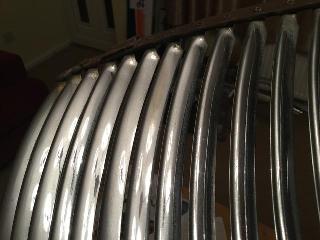
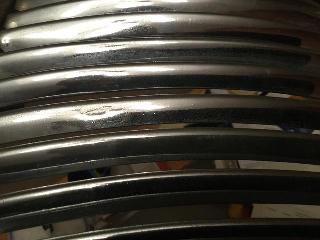
 For comparison with the more common later 1500 grilles, Don Tremblay in Rutland, USA wrote: For comparison with the more common later 1500 grilles, Don Tremblay in Rutland, USA wrote:
 "I checked out the composition of the 1/2 dozen or so original grilles that I have and found the following: "I checked out the composition of the 1/2 dozen or so original grilles that I have and found the following:
Shells are brass
False nose pieces are brass
All brackets (6 qty.) are magnetic
The grille slate retainer strips (2 qty.) are aluminum
The rivets holding the slats in non loaded areas are aluminum
The rivets holding the brackets are magnetic
The slats (I tested 5 original sets) are magnetic which really surprised me. I would have thought that they were stainless (magnetic stainless) or brass.
None of the slats appear to be chromed.
|
"No aluminum retainers. Note the steel strengthener in the center, this fits behind the shell, the rivets retaining the slats to brackets are steel, the other slat flat rivets are brass not aluminum, they look grey but on scraping one clean its brass, the first picture, look closely at the slats, the one has gone gold looking where I have gone through the chrome plate, also look closely and you can see the oxidation/ pitting ageing of the chrome on the slats".
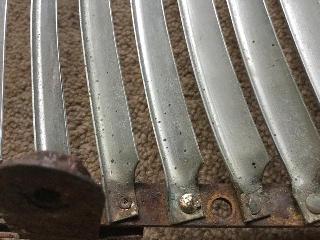
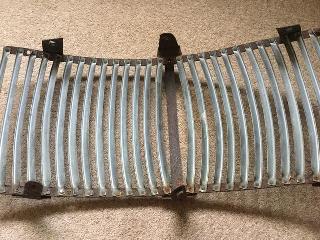
"Picture of the front. Note particularly the ageing of the chrome on the slats. I have acquired a repro grille that I thought of using but noticed that whilst the curvature was okay the profile of it was very different to this old grille".

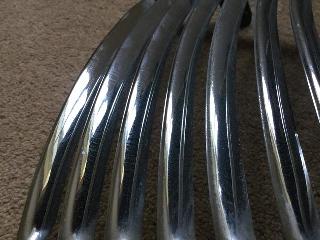
Very interesting. Not that I doubt any of this, just that it appears to be new information that is different than common knowledge. So I would like to see it verified before acknowledging it as original. As David wrote in his original post, "does anyone else have or heard of a grille like this"? Inquiring minds want to know.
Addendum December 28, 2020:
George Goeppner in Illinois, USA wrote:
"The SPL calls for 8 "D washer for grill studs" (ARJ509). What are these and how are they used? Why 8? Is there a supplier for them"?
The SPL has multiple errors here, swapping descriptions and/or locations with part numbers and incorrect (or ambiguous) quantities. And fasteners were changed for the 1600-MK-II recessed type grille. I will try to get it corrected here.
 Mark Wellard in Queensland, Australia wrote:
Mark Wellard in Queensland, Australia wrote:
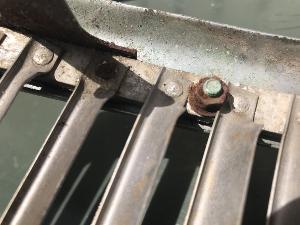 "My original grille has only one D washer and a spring washer under the 3/16" nut at each of the four slat mounts. Between the slats and the shell there is nothing at the top, but at the bottom, there are two larger diameter spacer washers on each side. These are 7/16" OD and 9/32" ID (1/4" narrow flat washers). As you can see from the picture, the cutout on the D washer sits next to the slat. A full round washer would flatten the lip on the slat".
"My original grille has only one D washer and a spring washer under the 3/16" nut at each of the four slat mounts. Between the slats and the shell there is nothing at the top, but at the bottom, there are two larger diameter spacer washers on each side. These are 7/16" OD and 9/32" ID (1/4" narrow flat washers). As you can see from the picture, the cutout on the D washer sits next to the slat. A full round washer would flatten the lip on the slat".
You can buy D-washers from McMaster Carr (although maybe not in this
exact size): www.mcmaster.com/d-shaped-washers
For the MGA 1500/1600 flush front grille, there are (2) ARH899 Stud at bottom (#1-32-UNF coach bolts), and (2) ARH898 Stud at top (#10-32=UNF square head studs) Beginning from front to back, the bottom bolt assembly stack up would be, #10 bolt head, outer shell, 1/4-in spacer washers (2), inner grille slat assembly, #10 "D" washers (1 or 2 as noted below), #10 spring washer, and #10-32-UNF hex nut.

. . Fasteners to assemble the 1500/1600 grille:
28 - ARH898 Stud -grille retaining (upper) (2) -(#10-32-UNF square head stud
29 - ARH899 Stud -grille fixing (lower) (2) -#10-32-UNF coach bolt
32 - ARK931 Washer -grille fixing stud (lower) -1/4" special narrow (4)
(may be 2 for 1600-MK-II)
39 - ARJ509 'D' washer for grille studs (4) -#10 -Fin.(C)100351
40 - LWZ203 Washer -spring -stud -#10 (4)
41 - FNZ103 Nut for grille studs (4) - #10
. . Fasteners to assemble the 1600-MK-II grille:
Similar to above, plus four additional screws for recessed shell to slats assy.
38 - PMZ0308 Screw -fixing panel (4)
39 - PWZ103 Washer -plain -stud -#10 (4) -#10 -Com.(C)100352
40 - LWZ203 Washer -spring -stud -#10 (4)
There are spacer washers between the grille surround panel and the inner grille slats assembly. Mark Wellard reports (2) spacer washers each side at bottom only. These are 1/4-in narrow flat washers with center hole just large enough to clear the corners of the square neck on the coach bolt. Two washers required is understandable for the height of the square neck not to interfere with the inner grille slats assembly. If holes in the slat assembly rails may be large enough to clear the square neck, then perhaps the spacer washers are an after thought, or "as required" for clean alignment of slats to shell. That could be a function of original shell flange height, and it could be different for aftermarket parts. These flat washers are extra small OD, about equal to head diameter of the coach bolt, which may mean a special part number, not a normal off the shelf washer.
Also only one "D" washer in each of four locations. I don't think there are 8 of anything anywhere. To have 8 "D" washers they would have to be stacked in pairs, possibly intended to clear some excess height of the bent up edge flange on the grille slats. But a single "D" washer plus a spring washer may be enough height for the hex nut to clear the edge of the slat.
The "D" washers were replaced with (4) PWZ103 plain washers Com.(C)100352. That is with the introduction of the 1600-MK-II recessed style grille. Again I don't know why. Maybe the slats or rivet holes were changed to give more side clearance for the washers. But with this information you should be able to install enough of the appropriate type of washers to achieve a clean assembly.
|








